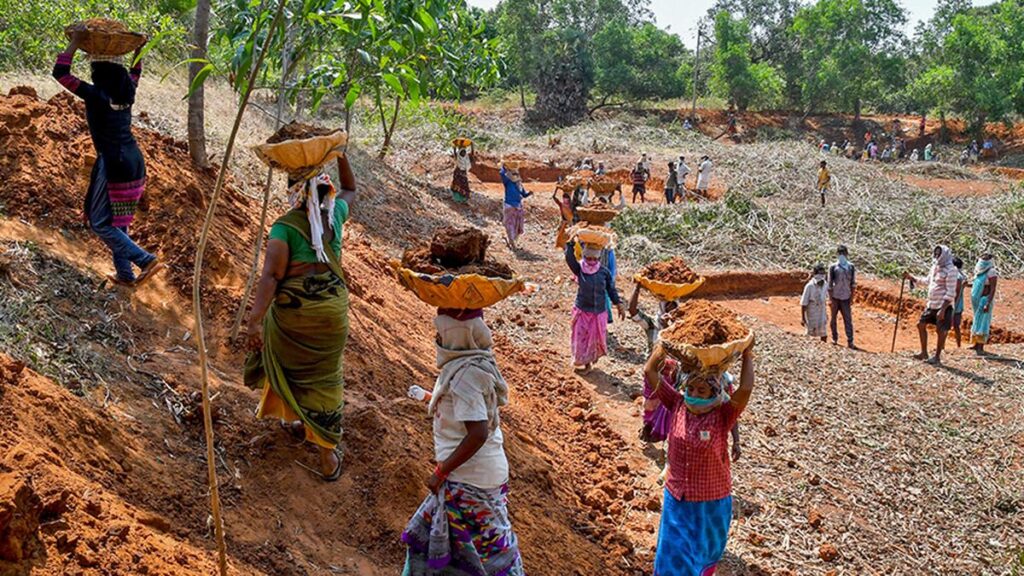
MGNREGA registrations grew by 3.1% in Andhra Pradesh, and the number of unique households that worked increased by 0.8%, in contrast to a 3.5% fall at the national level
| Photo Credit: Representative Image
Andhra Pradesh has shown improved participation and reversal of deletions, but work duration and wages continue to slide in the implementation of the Mahatma Gandhi National Rural Employment Guarantee Act (MGNREGA) during the financial year 2024-25.
A new report by LibTech India presents a mixed picture of MGNREGA implementation in Andhra Pradesh. While the State has made notable strides in improving participation and re-including previously deleted workers, it continues to grapple with serious concerns around the extent of employment provided, wage realisation, and responsiveness to climate-induced distress. MGNREGA guarantees employment to registered rural households who demand employment.
The report MGNREGA in Andhra Pradesh: A Data-Driven Assessment for FY 2024–25, released on April 16, draws on official data as of April 7 and compares the State’s performance with both the previous year and national trends.
‘Worker re-entry’ and ‘Participation retention’ are some of the bright spots. One of the strongest recoveries observed was in worker inclusion. The State recorded net additions of 1.95 lakh households and 2.72 lakh workers—the first such reversal of deletions since FY 2021–22. “This shift toward re-inclusion is significant,” says Mantri Diwakar, Data Analyst at LibTech India. “It reflects a policy course correction and opens the door to restoring access to entitlements,” he tells The Hindu.
Despite a national decline, Andhra Pradesh managed to retain participation better than most States. MGNREGA registrations in the State grew by 3.1%, and the number of unique households that worked increased by 0.8%, in contrast to a 3.5% fall at the national level.
Policy shocks mar momentum
The financial year began on a strong note with persondays in April 2024 surging 52.3% compared to April 2023. However, this momentum was abruptly disrupted by a 56.4% drop in July, following a Ministry of Rural Development advisory on May 7 regarding expenditure norms. Though employment levels improved in the latter half, they did not fully recover.
Mr. Diwakar says the advisory of the Union government, coupled with the delayed fund release by it, contributed to hampering the State’s ability to sustain employment generation.
Fewer workdays
The average number of days of employment provided per household fell from 54.89 to 51.62, a 6% decline, steeper than the 3.6% national dip. While Andhra Pradesh’s average still exceeded the national average of 50.21, the decline raises alarm about the actual support households received.
Even more telling was the 25.8% drop in households completing 100 days of employment, from 6.87 lakh to 5.1 lakh. This figure is key to understanding the extent to which MGNREGA meets its promise of employment security. “These metrics suggest that while households may have remained on the rolls, the quantum of work offered fell sharply,” Mr. Diwakar says.
Wage gaps and income losses
The wage realisation gap widened this year. On average, workers earned 14% less than the notified wage, up from a 9.7% shortfall in the previous year. This gap has resulted in an estimated ₹661 crore shortfall in total wage payments. Consequently, the average MGNREGA income per household fell from ₹13,484 to ₹13,190 despite a rise in the notified wage. If the previous year’s wage realisation rate had held, the average household income could have reached ₹14,721, Mr. Diwakar says, adding: “That’s a loss of ₹1,531 per household, which is substantial when MGNREGA wages are already well below minimum wages and the prevailing market rates.”
Drought-hit districts left behind
The report also flags a worrying disconnect between declared drought conditions and MGNREGA employment provisioning. On March 31, 2025, the Andhra Pradesh government declared 51 mandals in six districts as drought-affected. Of these, 37 were marked as severely affected. Yet, except for Sri Sathya Sai and Anantapur, all affected districts reported declines in MGNREGA employment.
“This failure to ramp up employment in times of rural distress undermines the scheme’s role as a social safety net,” Mr. Diwakar observed.
District-level variations highlight inconsistencies. Employment trends varied widely across districts. While 17 of 26 districts experienced a decline in persondays, Sri Sathya Sai district bucked the trend with an 18.2% increase. In contrast, Vizianagaram witnessed the sharpest drop at 17.8%.

“Reversing deletions is a crucial first step, but the road ahead lies in ensuring sustained employment and fair, timely wages, without which the promise of MGNREGA remains only partially fulfilled”Mantri DiwakarData Analyst at LibTech India
A mixed bag with clear priorities ahead
The LibTech India report makes clear that Andhra Pradesh has taken important steps forward in areas like participation retention, and reversing exclusions. Yet, these gains are offset by a decline in work provision and wage fulfilment, especially troubling in a year marked by drought and funding constraints. “Reversing deletions is a crucial first step, but the road ahead lies in ensuring sustained employment and fair, timely wages, without which the promise of MGNREGA remains only partially fulfilled,” says Mr. Diwakar.
Published – April 17, 2025 11:45 pm IST
Source:https://www.thehindu.com/news/national/andhra-pradesh/study-presents-mixed-picture-of-mgnrega-implementation-in-andhra-pradesh/article69461437.ece

